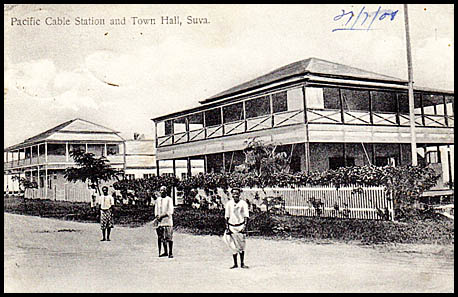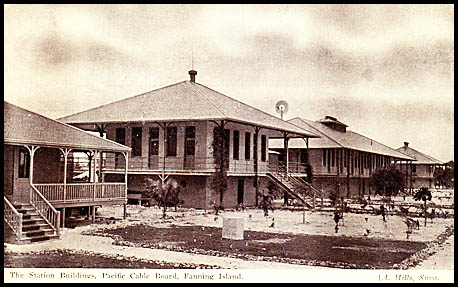The route and construction.
- Home, index, site details
- Australia 1901-1988
- New South Wales
- Overview of NSW
- Telegraph lines
- Telegraph Offices
- Date stamps
- Forms
- Envelopes
- Rates
- Stamps
- Queensland
- Overview of Qld
- Telegraph lines
- Telegraph offices
- Date stamps
- Forms
- Envelopes
- Rates
- Stamps
- South Australia
- Overview of SA
- Telegraph lines
- Telegraph Offices
- Date stamps
- Forms
- Envelopes
- Rates
- Stamps
- Tasmania
- Overview of Tasmania
- General developments
- Reports
- Organisation
- Telegraph lines
- Telegraph Offices
- Date stamps
- Railway lines
- Forms
- Envelopes
- Rates
- Stamps
- Overview of Tasmania
- Victoria
- Overview of Vic.
- Telegraph lines
- Telegraph offices
- Date stamps
- Forms
- Envelopes
- Rates
- Stamps
- Ephemera
- Western Australia
- Overview of WA
- Telegraph lines
- Telegraph Offices
- Date stamps
- Forms
- Envelopes
- Rates
- Stamps
The final route - as is shown on the Pacific Cable Board's logo - took the cable:
|
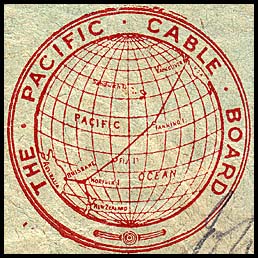 |
| Southport, Queensland.
Tenders were open for the construction of offices and the Superintendent's quarters for the Pacific Cable Station at Southport from March 1902 to 4 April. This building was separate from the Post & Telegraph Office in Southport which handled all domestic telegraph business. Mr.T. C. Judd was appointed Superintendent of the Station. A training school was also established at Southport.
|
 |
| The Queenslander of 7 October 1905 noted that "messages pass through the Southport office in under one and a-half minutes. The greatest care is exercised in safeguarding against error and in attaining smart handling of traffic. The success of the system is evidenced by the fact that although some half-million cablegrams had been received in the Southport office (in the first three years of operation), on no occasion has a loss of a message occurred". | |
Southport, Queensland to Norfolk Island (Anson Bay). Laid by C.S. Anglia. Commenced: 8 March 1902. Completed:
18 March 1902. Work began on the Australian end of the Pacific cable by floating the cable ashore on buoys at Southport on 6 March. The finishing touches to the land connection took an additional day. The sea bed to Norfolk Island was certainly a changing landscape. About 120 miles east of Southport, the water rapidly shoaled because of the presence of previously unknown hills. Between the hills, there was deep water. In laying the cable, it was thought better to avoid the hills altogether and move south - especially considering Norfolk Island is south of Southport. After the Queensland bank, the sea bed sloped down to about 2,000 fathoms for about 50 miles before levelling out at 2,500 fathoms (the deepest was 2,880 fathoms) for nearly 400 miles. It then rose over the next 131 miles to between 900 to 700 fathoms, sank over 73 miles to 2,000 fathoms, rose over 23 miles to 1,400 fathoms then back down to 1,950 fathoms. It gradually rose again in 50 mile intervals to reach the Norfolk Island bank which was about 7 miles wide. On arrival at Norfolk Island, there was too much surf to allow the cable to be brought ashore and so the work had to await better conditions. |
| Norfolk Island (Anson Bay). | 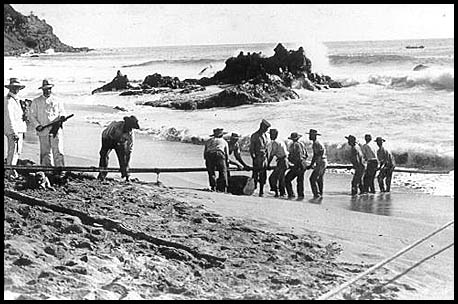 Bringing the Cable ashore at Norfolk Island, 1902. |
Norfolk Island to New Zealand (Doubtless Bay). Laid by C.S. Anglia. Commenced: 20 March 1902. Completed:
26 March 1902. Although most of the sea bed between Norfolk Island and New Zealand was good for the cable (being covered with globigerina ooze), there were some areas where the bottom was very hard rock. The route was therefore changed to avoid these areas. The section from 17 miles south of the Norfolk Island bank ranged between 1,150 and 2,800 fathoms. |
|
Mr. Hertzlett, chief Clerk of the Greymouth Post Office, was appointed Superintendent of the Doubtless Bay Cable Station. The Australian-New Zealand section of the Pacific Cable opened for business on 1 April 1902. |
Norfolk Island to Fiji. Laid by C.S. Anglia. Commenced: 3 April 1902. Completed:
10 April 1902. This was the most dangerous and trying section of all. A massive cyclone hit on the night of 5 April. The steam driven steering broke and the captain had to use the propellers and the hand mechanism. As the process could not be interrupted and it was impossible to keep to a direct line in the conditions, more cable than had been anticipated was laid down. For the first 150 miles from Norfolk Island, the sea bottom was coarse sand mixed with coral debris at a depth of 120 fathoms followed by fine sand to 350 fathoms and then globigerina ooze to a depth of 2,200 fathoms. Within the next 15 miles, the depth decreased to only 842 fathoms showing a significant hill on the sea floor which would have to be avoided. About mid-way between the two islands the sea bottom was mainly manganese and pumice with casts and shells of foramanifera. The direct route passed close to Conway reef so the path was diverted to the east to get into deep water - up to 2,600 fathoms which was probably within an old crater. by a further 25 miles, the sea bed was at 872 fathoms with good ground from there to Suva. |
Fiji to Fanning Island. Laid by C.S. Anglia - this section was the last to be laid. Commenced: 18 October 1902. Completed:
31 October 1902. The sea bottom over the first 600 miles east from Fiji had many separate rocky hills and hard ground which had to be missed when laying the cable. After that, the sea bed sank to a depth of 3,700 fathoms to a good basis of radiolarian ooze before rising to 1,570 fathoms only 14 miles from Fanning. In November 1926, the Fanning Island-Fiji section was duplicated by the C.S. Faraday. |
Fanning Island to Vancouver (Bamfield Creek). Laid by C.S. Colonia. Commenced: 18 September 1902. Completed:
6 October 1902. Four types of cable were used in this section - each having the same section for the core:
The cable in this section had 600 pounds of copper and 340 pounds of gutta percha per nautical mile plus the outside covering and sheathing. This design would enable between 70 and 80 letters per minute for manual transmission. An automatic transmitter would increase this speed by 30% to 104 letters per minute. The use of a duplex machine increases this rate further to about 166 letters per minute or about 21 words per minute. In November 1926, the Vancouver-Fanning Island section was duplicated by the C.S. Dominia. The cable was paid out at a rate of 300 miles of cable each day - allowing 6 per cent of slack for the hills and valleys of the ocean bed. |
| Vancouver Island (Bamfield).
Today Bamfield is really only accessible by boat - the alternative being an arduous drive of nearly 100 kilometers over a road primarily used for logging. The only real signs of the original Cable Station are a plaque in French and English surrounded by a globe made from recovered cable. |
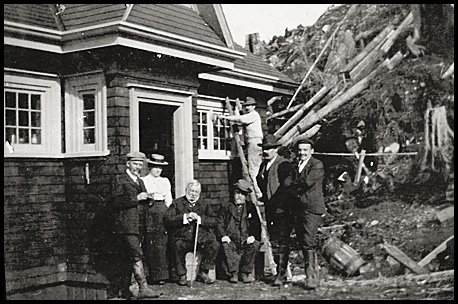 |
The modern pictures here were taken by Chris London. The 1902 picture was taken by Henry Clifford. Good references to Bamfield are:
|
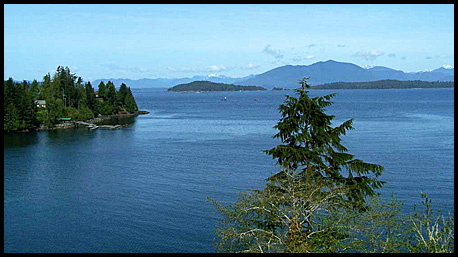 Bamfield today. |
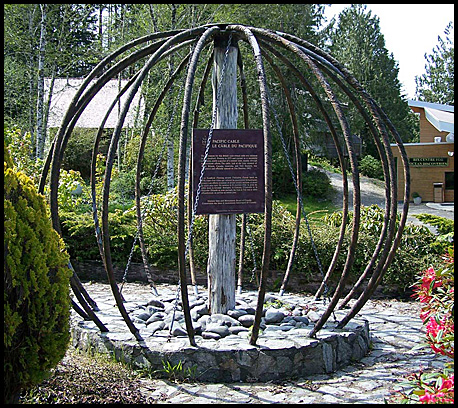 The globe made from recovered pieces of cable. |
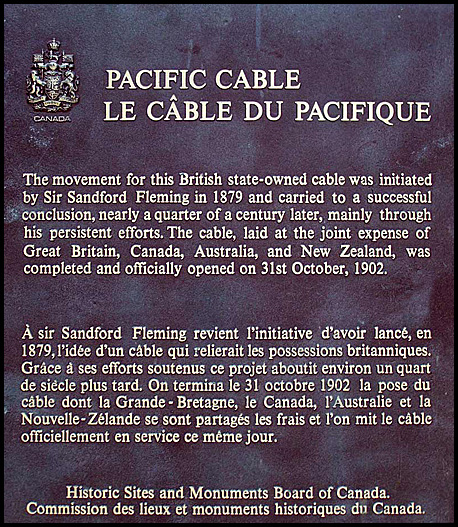 The plaque inside the"globe". |
The implications of the volume of traffic which might be handled for the Australian telegraph lines were not fully anticipated. Indeed it was not until June 1902 that some reaction started:
"When cable business is distributed from Brisbane, a paragraph in the " Argus" says, there will be a very heavy tax upon the telegraph wires between that city and Sydney. Unless their number is added to, it may happen that ordinary interstate telegrams will be delayed by the new traffic. In these circumstances, the Federal Minister has been asked to erect a special wire between Brisbane and Sydney to transmit cable messages only. The application is now under consideration".
Brisbane Courier, 4 June 1902.
New Cables
On 29 July 1911, a number of newspapers reported that "The bill which the House of Commons agreed to on the previous day authorises the Pacific Cable Board to construct a second cable between Australia and New Zealand. The cost is to come out of the reserve fund.
The work of laying the Pacific Cable Board's new Pacific cable began on 26 October 1926 with the landing at Bamfield, British Columbia of the shore end of the cable. The cable ship Dominia immediately commenced paying out to Fanning Island. Bamfield, which is the terminus of the board's cable, is 100 miles north of Victoria (British Columbia).
Canberra Times, 4 November 1926.
The work of laying the new Pacific cable is progressing very satisfactorily The shore end of the section Fanning Island to Suva was laid by the cable ship Faraday on 2 November and the Faraday is now paying out to Suva (5 November 1926).
October 26 1926
Newcastle Morning Herald and various papers
The Pacific cable is a great Imperial undertaking, under the joint control of the Governments of Great Britain, Australia, Canada and New Zealand. It has proved a most reliable means of communication and, in that respect, played a very important part during the years of war.
Although the beam wireless system between Australia and Britain will be in operation within a few months, it is not likely that it will displace the cable. The continued reliance on the older form of communication is shown by the commencement which will shortly be made in the laying of duplicate cables. The work has involved the building of a ship of 9,250 tons to carry the 3,500 miles of cable which are to be laid between Bamfield and Fanning Island- along which route a depth of 3,400 fathoms is reached. The cable to be laid between Fanning Island and Suva will be 2,043 miles long and the total cost of the undertaking will be nearly £2,750,000.
The work has been necessitated by the increase of business and, by the adoption of the latest scientific method in cable construction, a speed of 600 letters per minute in one direction will be possible. As the trade and commerce of Australia have developed, means of rapid communication with countries overseas have become of increasing importance. This is especially so in regard to the export of primary products. Each year has seen the wool salon in this country expand. Buyers come here from almost every manufacturing country in the world and they would not come unless there was such means of communication as those provided by the cable service. The enormous demand on the Pacific cable is a direct result of its reliability. There are certain classes of business which are carried out almost completely by such means.
The laying of the duplicate cables is being accompanied by the installation of the latest forms of apparatus at all the stations on the route. The service "via Pacific" has played a dominant part in Imperial communications for many years and when the work now being undertaken is completed, there will open up a new era of efficiency".
